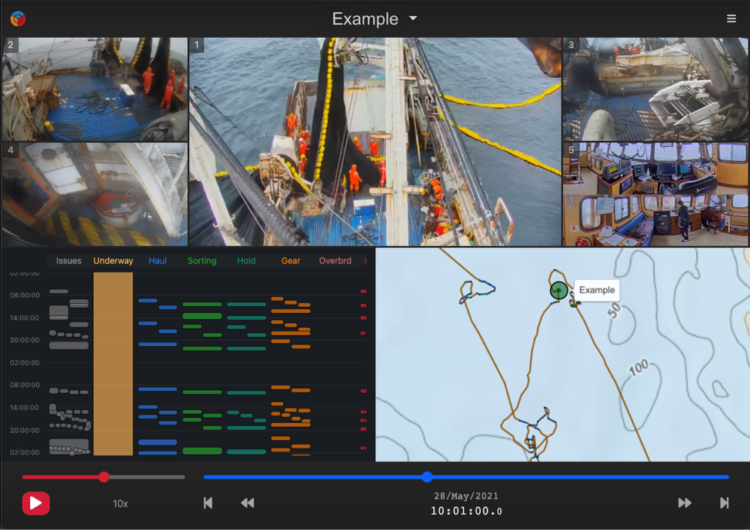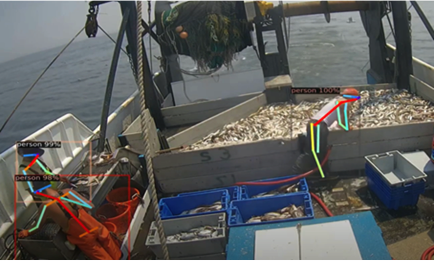Integrated Monitoring was founded in 2018 in Boston, Massachusetts. We develop cloud-based Monitoring, Control and Surveillance applications for the maritime sector, including a flagship on-line review platform—Monitor—which provides real-time access to video, GPS tracks and telemetry on any device.

As the ‘fourth industrial revolution’ gathers pace, innovations become faster, more efficient, and more widely accessible. This merging of the digital, physical, and biological realms is enabled by cloud computing, artificial intelligence (AI), Internet-of-Things (IoT), blockchain, and other advanced technologies that will revolutionize and reshape both infrastructure and the ways we interact with our environment.
Innovations like these are supported by dramatic improvements in global connectivity—including 5G cellular, broadband satellite Internet, and edge-based machine vision processing. At Integrated Monitoring we use these technologies to provide faster object detection and reactions; predictions delivered in real-time from vessels located thousands of miles away; and, for the commercial fishing industry, real-time analytics on catch & discards to improve supply-chain efficiency and the quality of scientific research.
Additionally, crew welfare applications—including text, email, voice, and social media—are a priority for our R&D team, because keeping crews in contact with families and friends makes fishing operations more efficient, less stressful, and safer.
Today, Integrated Monitoring technology is found in fisheries across the United States, Maldives, Chile, Peru, Mexico, and Indonesia; with additional markets to follow.
Early adopters of our systems include several of the world’s largest fishing companies; the National Oceanic and Atmospheric Administration (NOAA); the United States Coast Guard; SERNAPESCA, the Chilean fisheries regulator; and the Ministry of Fisheries, Marine Resources & Agriculture in the Maldives, under a World Bank-funded deployment. All our projects are delivered in partnership with highly qualified integrators, who handle distribution, installation, and local support.
Rapid rollout of the technologies we’ve developed were facilitated by financial and technical support from the National Fish and Wildlife Foundation (NFWF), the National Institute for Occupational Safety & Health, the Massachusetts Department of Marine Fisheries, the University of Massachusetts, and the Massachusetts Institute of Technology, under their Sea Grant program.
Onboard Technology Platform
We provide a full “technology stack”—partnering with leading satellite and cellular companies to specify and integrate complete onboard technology packages. We source video technology from leading camera manufacturers, with most models supporting up to 4K resolution, along with thermal infrared and pan-tilt-zoom options. Wireless temperature, pressure, and movement monitoring sensors can also be installed. Data is collected, stored and transmitted in encrypted form through the Secure Communications Server; a rugged, wide-temperature-range onboard computer.

Enabling New Approaches to Fisheries Management
Increasingly, new fisheries regulations will require real-time monitoring for effective area enforcement, quota monitoring, and accurate science—challenging the methodological and budgetary limits of existing data collection tools and tech capabilities. We are addressing these emerging needs with higher bandwidth data services and sophisticated data collection and analysis tools.
In New England: NFWF and USCG Research Projects
Broadband communications equipment enables entirely new fisheries management  approaches that are dependent on continuous Internet access. During 2019-2021, funding from NFWF enabled us to test three such scenarios: (a) combining real time tracking, catch, telemetry, and imagery datasets, while the vessel was underway; (b) demonstrating at-sea catch reporting using open protocols that meet FIPS/NIST security standards; and, (c) using advanced AI tools in combination with pan-tilt-zoom cameras to capture exceptionally high-resolution imagery for species recognition purposes, based on tracking crew activity across the fishing deck using machine vision.
approaches that are dependent on continuous Internet access. During 2019-2021, funding from NFWF enabled us to test three such scenarios: (a) combining real time tracking, catch, telemetry, and imagery datasets, while the vessel was underway; (b) demonstrating at-sea catch reporting using open protocols that meet FIPS/NIST security standards; and, (c) using advanced AI tools in combination with pan-tilt-zoom cameras to capture exceptionally high-resolution imagery for species recognition purposes, based on tracking crew activity across the fishing deck using machine vision.
In the Maldives: National Deployment of Satellite Internet
The declining cost of technology has enabled adoption by small-scale and artisanal fleets. In the Republic of Maldives, where fishing provides jobs to over 30% of the population, a national rollout of Fleet One Broadband VMS and Integrated Monitoring’s wireless monitoring system is underway.
 Najib Khan, CEO of Ooredoo Maldives—the prime contractor for this project—explained that, “We placed high importance in onboarding partners that share our values of bringing new socio-economic progress to societies through innovative technologies. The Fleet One Vessel Monitoring System ensures seamless monitoring of fishing vessels for owners and the regulator, and enables new opportunities for the crew, while assuring their safety onboard. We look forward to seeing the progression of the fisheries industry in the Maldives, supported by this project.” Jeff Douglas, CEO of Integrated Monitoring, elaborated on the technology, “Fleet One is over twenty times faster than traditional Vessel Monitoring Systems. For the first time, this can provide crew chat, mobile-banking and live video monitoring to the small and mid-sized fisheries segment.”
Najib Khan, CEO of Ooredoo Maldives—the prime contractor for this project—explained that, “We placed high importance in onboarding partners that share our values of bringing new socio-economic progress to societies through innovative technologies. The Fleet One Vessel Monitoring System ensures seamless monitoring of fishing vessels for owners and the regulator, and enables new opportunities for the crew, while assuring their safety onboard. We look forward to seeing the progression of the fisheries industry in the Maldives, supported by this project.” Jeff Douglas, CEO of Integrated Monitoring, elaborated on the technology, “Fleet One is over twenty times faster than traditional Vessel Monitoring Systems. For the first time, this can provide crew chat, mobile-banking and live video monitoring to the small and mid-sized fisheries segment.”
In Chile: Interoperability
The National Fisheries Services of Chile (SERNAPESCA) has required electronic video  monitoring since early 2020. To facilitate video review by the government, and to promote broader scientific use of the datasets, the government also required interoperability between vendors, with an independent laboratory certifying each proposed solution. Integrated Monitoring is represented in Chile through Selmar, a well-respected maritine electronics distributor. In addition to their role as the largest supplier of on-board systems within the Chilean market, Selmar have been appointed as technical consultants to implement the Integrated Monitoring multi-vendor video review solution for SERNAPESCA’s monitoring center in Valparaiso, and are working closely on new initiatives to promote wireless monitoring, to automatically identify fishing activities through the use of AI, and to prepare for the expansion of the current regulation to cover additional vessels and the aquaculture sector.
monitoring since early 2020. To facilitate video review by the government, and to promote broader scientific use of the datasets, the government also required interoperability between vendors, with an independent laboratory certifying each proposed solution. Integrated Monitoring is represented in Chile through Selmar, a well-respected maritine electronics distributor. In addition to their role as the largest supplier of on-board systems within the Chilean market, Selmar have been appointed as technical consultants to implement the Integrated Monitoring multi-vendor video review solution for SERNAPESCA’s monitoring center in Valparaiso, and are working closely on new initiatives to promote wireless monitoring, to automatically identify fishing activities through the use of AI, and to prepare for the expansion of the current regulation to cover additional vessels and the aquaculture sector.
What’s Next?

As wireless video streaming—via satellite and cellular—becomes the predominant means of data transmission, further improvements to the efficiency of video compression are expected to reduce costs. Continual improvements to AI algorithms can then optimize exactly which data needs to be uploaded, enabling the global maritime fleet to benefit from an extraordinary increase in Internet bandwidth as new and upgraded satellite constellations come into service.
Currently, we are rolling out edge-based machine learning to ‘understand’ the broader context of fishing activities such as locations of each crewmember, the state of the fishing gear; and multiple fish being weighed, measured, and sorted simultaneously. Extending this ‘virtual observer’ concept is a priority: utilizing real-time video monitoring and panoptic machine vision approaches that can track objects across scenes and identify specific activities through key-point detection.
In the United States, NOAA’s National Policy on Electronic Technologies for Fisheries Dependent Data provides guidance on the implementation of electronic technologies. It encourages the use of open-source data standards to facilitate data integration, software flexibility, and to improve timeliness, quality, and cost-effectiveness [1]. At Integrated Monitoring, we fully support those efforts, along with complementary industry initiatives to cooperate on minimum capabilities and data standards.
Independent estimates show the market for these services growing tenfold over the next decade [2]. In our view, a key to enabling this level of growth is better integration of GPS tracking (VMS), Video Monitoring, Electronic Catch Reporting, IoT and crew welfare applications within a single system—and supporting existing maritime sales channels to undertake large-scale deployments. We look forward to extending our leadership role in this exciting, emerging field.
Josh Wiersma is Senior Advisor and Policy Liaison at Integrated Monitoring, Inc. He is happy to hear from readers and can be reached here. To feature your company, please drop us a line at info@em4.fish. You’ll find more Industry Focus profiles in our Blog section.
[1] https://media.fisheries.noaa.gov/dam-migration/04-115.pdf
[2] Catalyzing-EM-2020report.pdf (fisheriesem.com) https://fisheriesem.com/pdf/Catalyzing-EM-2020report.pdf


